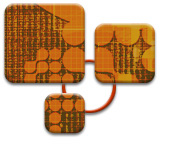|
 Topic
Summaries by Subject Topic
Summaries by Subject
Orienting Students
A1
Exercise to imagine yourself as an online student
A2.1
Profile of your distance learning students
A2.3
Sample Technology Survey to collect information from your online students
A4.2
Model for writing learning objectives for your online syllabus
B1.l
Exercise for instructors to get a taste of the online experience yourself,
as if they were students seeking information about your first online course.
B1.3
Survival tips for online students (handout or link)
B1.4
PowerPoint show used to orient students in a face-to-face orientation
B1.4
Link to successful students’ checklist
B1.4
Link to WebCT demonstration course (at CSM) that students can sample
The Online Syllabus
A3.3
Concept Map of the main component of an online course
B1.2
Components belonging on Course Home Page or Syllabus, such as course description,
course organization, etc.
B4.2
Questions to consider regarding submitting work, email, online discussions,
etc.
Communicating Online
A.5.1
Three kinds of online interaction
A.5.3
How to design a Web Quest for your online students
A.5.4
Types of student interaction with other students
A.5.5
Model for building a learning community online
B5.1, B5.2
Tips for managing a chat room
Group Work
A.5.3
How to design a Web Quest for your online students
B5.3
Strategies for building online teams (Powerpoint)
Giving Feedback
A.6.1
Techniques for giving feedback (either online or in your classroom)
B4.2
Using filenames that facilitate providing feedback to students
Online Discussions
A.5.2
Ohio State University provides guidelines for electronic discussions
B1.3
Protocols for group discussions
B5.3
Sample worksheet for grading online discussions
Self-Assessments
A1.1
Characteristics of an effective online instructor
A1.2
Chickering and Gamson’s “Seven Principles of Good Practice in Undergraduate
Education”
A1.2
Teaching Styles Inventory
A1-Additional Resources
Keirsey Temperament Sorter – self-assessment for the instructor
Paragon Learning Style Inventory (PLSI) – self-assessment for both instructors
and learners
A3.2
Audience Analysis Summary Worksheet
B1.4
Checklist for Online Faculty (what you should do BEFORE you teach online)
For Students
A1-Additional Resources
Keirsey Temperament Sorter – self-assessment for the instructor
Paragon Learning Style Inventory (PLSI) – self-assessment for both instructors
and learners
A2.3
Sample Technology Survey to collect information from your online students
A2.3
Self-scoring Learning Styles Questionnaire from NC State
Classroom Assessment
A2.1
Profile of your distance learning students
A2.2
Learner analysis for internet based instruction
A3.5
Instructional Evaluation Questionnaire (IEQ), used by CSM to evaluate an online
instructor’s effectiveness
A2.3
Self-scoring Learning Styles Questionnaire from NC State
A3.2
Audience Analysis Summary Worksheet
A3.5
Instructional Evaluation Questionnaire (IEQ), used by CSM to evaluate an online
instructor’s effectiveness
A.6.1
Grading vs. Assessment
A.6.1
Links to a wide variety of Classroom Assessment Techniques (CATs)
A.6.2
Adobe PDF Know-Want To Know-Learned (KWL) chart
B1.4
Link to WebCT demonstration course (at CSM) that students can sample
B4.5
Example of Master Course Site
B5.3
Sample worksheet for grading online discussions
Dealing With Class Problems
B5.4
Dealing with problem behaviors including the “sleeper,” the “free
rider,” and the “disruptive” student.
Managing Time
B4.1
Create a “master course site” which can be used for all your online
(and perhaps traditional) courses
Handling E-mail
B4.2
Using filenames that facilitate providing feedback to students
Online Technology
A2.3
Sample Technology Survey to collect information from your online students
A10.6
Tips for making your online syllabus easier to navigate
A10.7
An explanation of how to insert “hyperlinks” into your web pages
B2.1
Links to Macromedia Flash and Shockwave
B2.2
Questions about hardware
B2.3
Questions about software
B2.4
Web browsers (Internet Explorer, Netscape, Opera)
B2-Additional Resources
Description of browsers and plug-ins
Solving Technical Problems
B4.4
Backup Strategies for tech problems
WebCT
B1.4
Link to WebCT demonstration course (at CSM) that students can sample Examples
A.6.2
Adobe PDF Know-Want To Know-Learned (KWL) chart
B.1.4
Link to WebCT demonstration course (at CSM) that students can sample
B.4.5
Example of Master Course Site
B.5.3
Sample worksheet for grading online discussions
TOP
|